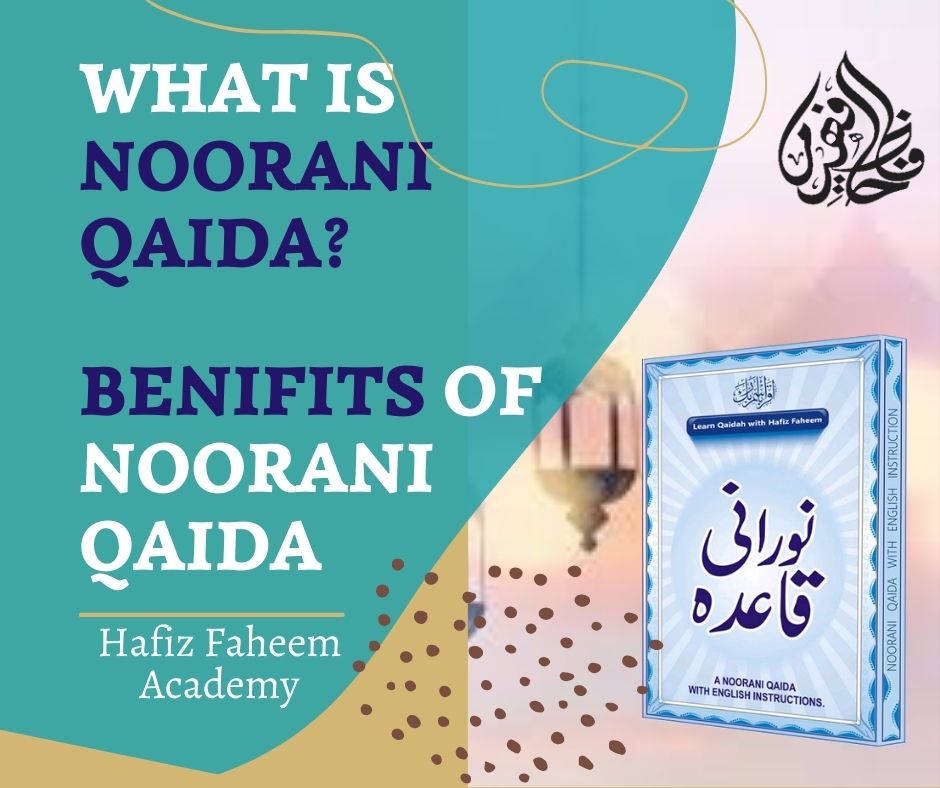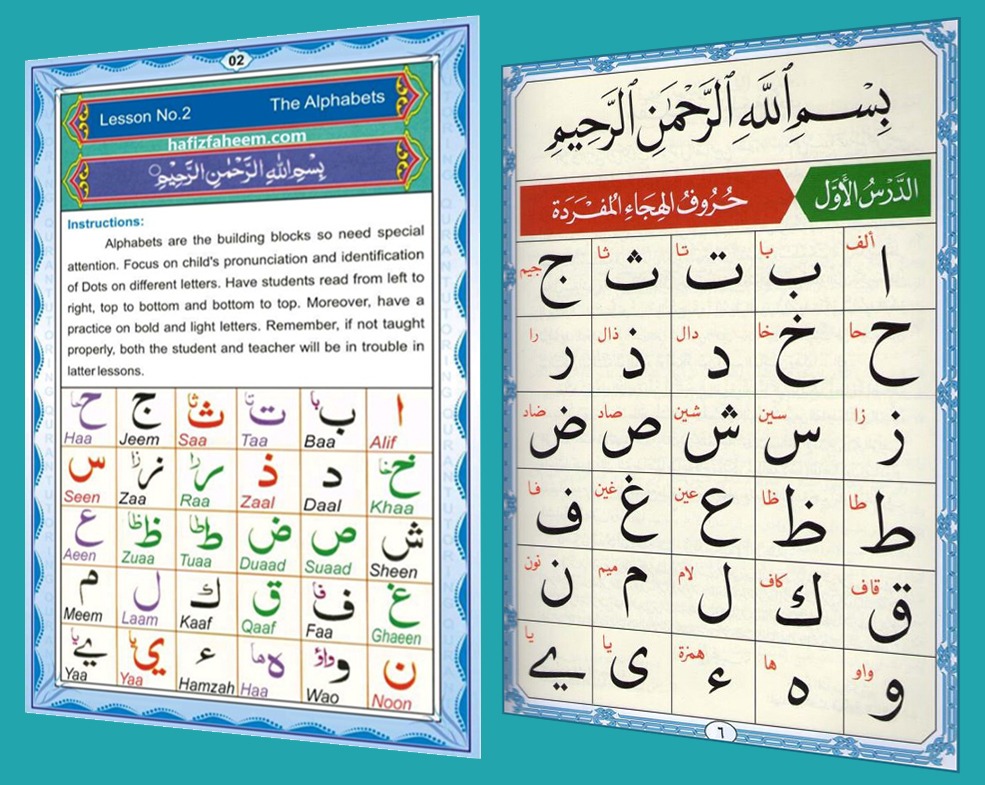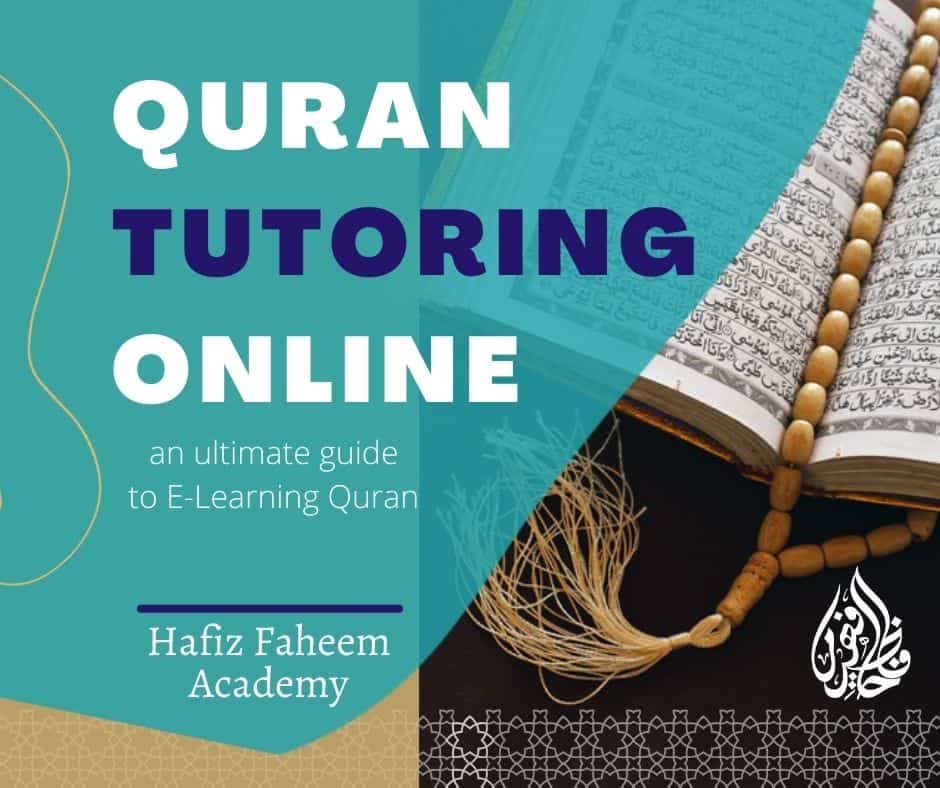What is noorani qaida?
Noorani Qaida is the basic Arabic book to learn Quran Reading with proper pronunciation for beginners. This book is the ideal method to learn Quran and Tajweed with simple and effective way.
This is the most famous, popular, useful and highly recommended Book for those who want to learn to read the Quran from the very basic. This book is considered as the foundation of learning Quran.
The Noorani Qaida book written by Sheikh Noor Muhammad Haqqani from Ludhyana India. It was named Noorani Qaida | Al-Qaidah Al-Nooraniyah on the Sheikh name “Noor”. Originally, Noorani Qaida book was written for non-Arabs, but due to its immense usefulness, the book become popular throughout the Muslim world.
Now, the majority of the Muslims all around the world start their learning reading Quran with this Noorani Qaida book. We can say this book is the first step towards learning Quran.
Who should learn Noorani qaida?
Whether you are Arabs or non-Arabs, if you are new to learn Quran reading, it is very important to learn Noorani Qaida book. It is not only important for kids but it is also very useful for adult men and women who want to learn Quran from the beginning.
Also if you know how to read Quran but you haven’t read it for a long time and you are not able to recognize the movements/harakat and you face difficulty in reading Quran, then you can take full advantage of this Qaida book.
what are the bnenefits of learning noorani qaida?
1. Noorani Qaida makes you able to read the Arabic Alphabet leading to the words and sentences with proper pronunciation.
2. Without knowing the movements – Harakat, it is impossible to read Quran accurately. Noorani Qaida helps you to learn movements – Harakat in a very easy and effective way. It teaches you how to connect letters and words together.
3. Noorani Qaida can build a solid foundation for Quran reading with Tajweed.
4. Noorani Qaida is beneficial for all native Arabs or non-natives. Who cannot read the Quranic words, until they know the basic rules about how to pronounce the Arabic letters.
5. Noorani Qaida is the building block of learning Quran recitation, If you are willing to learn the Quran accurately, You are supposed to learn Noorani Qaida first of all. You cannot read the Holy Quran properly without learning the Noorani Qaida.
6. Noorani Qaida is designed with a well-organized curriculum and a lot of exceptional exercises, which include Quranic words and verses, that make you master Quran recitation.
7. It will make Quran reading easier than you can think, You will learn the accurate pronunciation of Quranic words and verses.
8. It will start from the Arabic Alphabet – isolated letters, Joint letters/compound letters, connecting alphabets with the help of symbols, at the finishing of this book it will leave you with the ability to read Quranic words and verses with proper pronunciation.
9. Noorani Qaida book covered all Symbols – Movements – Harakat. such as Short vowels; Fatha, Kasrah, Dumma and Long vowels; Long vowels Huroof ul Madd & Huroof ul Leen, Standing Fatha, Standing Kasrah, Standing Dumma.
10. Noorani Qaida helps kids to develop child’s awareness, understanding, hearing, speaking, and reading skills. For adults, it helps to learn the accurate sound of words and to know how to recite the Holy Quran with Tajweed rules.
What is Harakat in Quran?
Harakat, Movements
These two words used in Quran learning process, specially in Noorani Qaida. The word Harakat is plural of Harakah (حرکۃ) which mean movements.
In Arabic language there are specific symbols that we put on Arabic letters as a vowels, but remember that Arabic vowels/harakat are not a part of Arabic alphabet. they are written as marks over or belong the consonant to make voice long or short, to connect letters in different way.
Understanding the symbols of Harakat/Movements/vowels is very important. without knowing symbols you cannot read Quran properly.
how many harakat are there in quran/arabic/Noorani Qaidah?
There are 11 Harakat in Arabic language:
1. Fatha: It give us sound of ‘A’
2. Kasrah: It give us sound of ‘E/I’
3. Dammah: It give us sound of ‘U’
Tanveen
4. Double Fatha – also called – Fathatain: It give us sound of ‘AN’
5. Double Kasrah – also called – Kasratain: It give us sound of ‘EN/IN’
6. Double Dammah – also called – Dammatain: It give us sound of ‘UN’
Three prolong symbols
7. Standing Fatha – also called – Al-Alif Al-Sagheerah
8. Standing Kasrah – also called – Al-Yaa Al-Sagheerah
9. Standing Dammah – also called – Al-Wao Al-Sagheerah
10. Sukoon: It is used for consonants. It’s shaped like Daal letter or small circle. The letter which has sukoon symbol, we pronounce it by connecting the letter before sukoon. to make it easy we can give example.
In English language, it is like a letter that comes after vowels. example; Big; here we are connection the letter ‘B’ with ‘G’ but in Arabic, we have to put sukoon symbol on ‘G’ to connect with the previous letter ‘B’. and ‘B’ has Kasrah which is representing the vowel ‘I’.
11. Shaddah: It’s a shape like ‘w’ if you see this symbol on any letter, you will have to pronounce that letter twice. instead of writing a letter two times, we write that letter once and put shaddah on it, so it becomes equal two.

how many Chapters / Lessons and pages in noorani qaida?
Noorani Qaida - Lesson No.1 - Arabic alphabets
First Lesson is about Arabic Alphabets. There are 29 alphabets in Arabic language. You will learn each Arabic alphabet with proper pronunciation from exact articulation point.
Noorani Qaida - Lesson No.2 - Joint letters
Second Lesson is about Joint Letters. In which you will learn different shapes of alphabets while connecting letters to make a proper word.
When we joint Arabic Letters, some time many letters come in different shapes. So you need to learn different shapes of alphabets. Because sometimes when one letter is written alone, it is written in full shape, but when it is combined with other letters, it is written half.
After completing this Chapter students would be able to identify each word from Quran.
Noorani Qaida - Lesson No.3 - The Muqat'taat Letters
Third Lesson is about Huroof ul Muqatta’aat. In which you will learn the. In addition, you will learn in this chapter the symbol of Madd. you will practice long madd. whenever you see this madd symbol you will have to read it longer.
Noorani Qaida - Lesson No.4 - The Movements (Short vowels)
symboForth Lesson is about Harakat/Movements/Short vowels. In which you will learn fiest 3 Harakat/Short vowels: (1) Fatha (2) Kasrah (3) Dammah. In excersize you will practice each letter with each Harakah.
Noorani Qaida - Lesson No.5 - Tanween
Fifth Lesson is about Tanween. Dauble Fatha, Double Kasrah, Double Dammah is called Tanween. In addition, you will learn one Tajweed rule Ikhfa.
What is Ikhfa?
Hiding the voice of meem or Noon partially in the nose is called Ikhfa.
When to do Ikhfa?
If Noon Sakinah or Tanween followed by these 15 letters: ت ، ث ، ج ، د ، ذ ، ز ، س ، ش ، ص ، ض ، ط ، ظ ، ف ، ق ، ک you have to do Ikhfa. So there are 15 Ikhfa letters / Huroof Ikhfa.
I know remembring these letters is not easy for beginners, so I would say remember and memorize 6 Throatal Letters, 6 Tarmaloon Letters and the letter ‘Ba’
Whenever Tanween or Noon Sakinah is followed by Throatal Letters, Yrmaloon Letters and ‘Ba’, Don’t do Ikhfa.
There are six Throatal Letters: ء ھ ، ع ح ، غ خ
There are six Yarmaloon Letters: ی ، ر ، م ، ل ، و ، ن These Letters grouped in the word: یرملون
And the Letter ب
Noorani Qaida - Lesson No.6 - exercize of Tanween & short vowels
Sixth Lesson is about practicing of six Harakat/Movements/vowels: (1) Fatha (2) Kasrah (3) Dammah (4) Double Fatha (5) Double Kasrah (6) Double Dammah that you read in the last two lessons. Here in this chapter with the help of these six Harakat/movements you will learn to read 54 proper Arabic & Quranic words.
Noorani Qaida - Lesson No.7 - Standing fatha, standing kasrah and standing dammah
Seventh Lesson is about 3 Prolong vowels: (1) Standing Fatha (2) Standing Kasrah (3) Standing Dammah or (1) Al-Alif Al-Sagheerah (2) Al-Wao Al-Sagheerah (3) Al-Yaa Al-Sagheerah. Here in this chapter I need your attention. There are two different way to use and write these symbols. The first one is used in Indo Pak script and the second one used in Arab Countries.
1. Standig Fatha is equal to Al-Alif Al-Sagheerah | The symbol of Standing Fatha is like small Alif on the top of the letter.
2. Standig Kasrah is equal to Al-Yaa Al-Sagheerah | The symbol of standing Kasrah is also like small Alif but on the bottom of the letter.
3. Standig Dammah is equal to Al-Wao Al-Sagheerah | The symbol of Standing Dammah is bit rounded from the top / upside down dammah / reverse Dummah.
In Ind o Pak script these three symbols represented as Standing Fatha – Standing Kasrah – Standing Dammah. It is the best and easy way for English speakers, specially for biggeners. Because it is very simple to spell.
In Saudi Script these Three symbols represented as a
(1) Al-Alif Al-Sagheerah | The symbol of Al-Alif Al-Sagheerah = small Alif after Fatha
(2) Al-Yaa Al-Sagheerah | The symbol of Al-Yaa Al-Sagheerah = small Yaa after Kasrah
(3) Al-Wao Al-Sagheerah | The symbol of Al-Wao Al-Sagheerah = small Wao after Dammah
These three prolong symbols need to read longer. Standing Fatha / Al-Alif Al-Sagheerah is equal to Alif Maddah. Standing Kasrah / Al-Yaa Al-Sagheerah is equal to Yaa Maddah. Standing / Dammah Al-Wao Al-Sagheerah is equal to Wao Maddah.
Join our noorani Qaida program
Noorani Qaida - Lesson No.8 - Huroof ul Madd and Huroof ul Leen
This Chapter has Two sections:
First section is about Huroof ul Madd / Maddah Letters. Madd ( مَدّ ) is Arabic word which mean stratching. So, Maddah Letters needs to read longer with stratching. There are Three Maddah Letters. و ، ا ی
The letter before Alif has Fatha, so Alif is called Alif Maddah, if the letter before Wao Sakin () has Dammah, Wao () is called Wao Maddah and if the letter before Yaa sakin () has Kasrah, Yaa () is called Yaa Maddah. They are Prolonged equal to one Alif can be stratch one to two seconds.
Second Section is about Huroof ul Leen / Leen Letters. There are 2 Leen Letters: ( و ، ی ) If the letter before Yaa Sakin and Wao Sakin has Fatha. Then these Yaa and Wao are called Leen letters. They are neither prolonged nor read with a jerk.
Noorani Qaida - Lesson No.9 - Practice of all previous Chapters
Chapter Number Nine is about practicing of all previous Chapters all Harakat, Tanveen, Standing Harakat, Madd and Leen. In this chapter we will apply all Harakat to read proper words. In this chapter you will learn to read 111 different words from Quran with the help of previous lessons.
This chapter will be very amazing for you. You will get confidence and motivation to success in Quran reading recitation because in the end of this lesson, you will be able to read 111 more Quranic words with proper pronunciation.
Noorani Qaida - Lesson No.10 - Sukoon (Jazm)
Noorani Qaida Chapter Number Ten is about Sukoon. It is also called Jazm. It is used for consonants. It’s shaped like Daal letter or small circle. The letter which has sukoon symbol, we read it by connecting with previous letter. e.g. Ab, EB/Ib, Ub. In this chapter we practice each letter with Sukoon.
Noorani Qaida - Lesson No.11 - Exercise of Sukoon (Jazm)
It’s not only Sukoon exercise but it will cover all Harakat/symbols long and short vowels. But you will see Sukoon in every word. You will learn 133 single words, 15 combined words, and 1 long verse.
Noorani Qaida - Lesson No.12 - Shaddah (Tashdeed)
Noorani Qaida Chapter Twelfth is about Shaddah. If you see this symbol on any letter, you will have to pronunce that letter twice. It is read with a strong voice. In other words I can say throw the previous letter on Shaddah letter strongly. e.g. Abba, Ebba, Ubba
Noorani Qaida - Lesson No.13 - Exercise of Shaddah (Tashdeed)
Noorani Qaida Chapter Thirteen – in this chapter you will practice Shaddah symbol on 52 single words, 2 combined words, and 2 complete verses. In total this chapter has 56 words to exercise.
Noorani Qaida - Lesson No.14 - Shaddah and Sukoon
Noorani Qaida Chapter forteen: Sometime you see Shaddah and Sukoon in one word. In this chapter you will learn and exercise how to connect and read Shaddah and Sukoon in one word. There are 21 words and 3 verses for practice. Each word has Shaddah and Sukoon. After reading that words you will get idea how to read Shaddah and Sukoon in one word.
Noorani Qaida - Lesson No.15 - Shaddatain - Two Shaddah in One Word
Noorani Qaida Chapter fifteen: You will exercise Double Shaddah.
Mean there will be two shaddah:
- in one word or
- First shaddah will be in the last letter of the first word and second one on the first letter of second word in two different words connecting each other.
Noorani Qaida - Lesson No.16 - Shaddah with Madd
Noorani Qaida Chapter Sixteen is exercise of Shaddah with Madd. Mean there will be One Shaddah and Madd in one word. In this Chapter you will learn how to connect letters while strachithing Madd. There are 11 examples to practice only but you will get idea and you will be able to aply on any word easily.
Noorani Qaida - Lesson No.17 - Last Chapter - Practice of All Harakat all symbols that you have learned in Noorani Qaida
Noorani Qaida Chapter Number Seventeen is the last chapter of Noorani Qaida. It’s all about practice. In this Chapter you will practice all Harakat/movements that used in Quran that you have learned in Previous Lessons. Also There are some special Tajweed Rules for practice such as Idgham, Iqlab, Izhar, and Ikhfa. You will practice 36 words/sentences/verses.






Pingback: What is Harakat in Quran? - Learn Quran Online with Best Quran Teachers